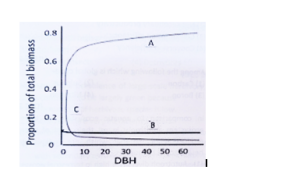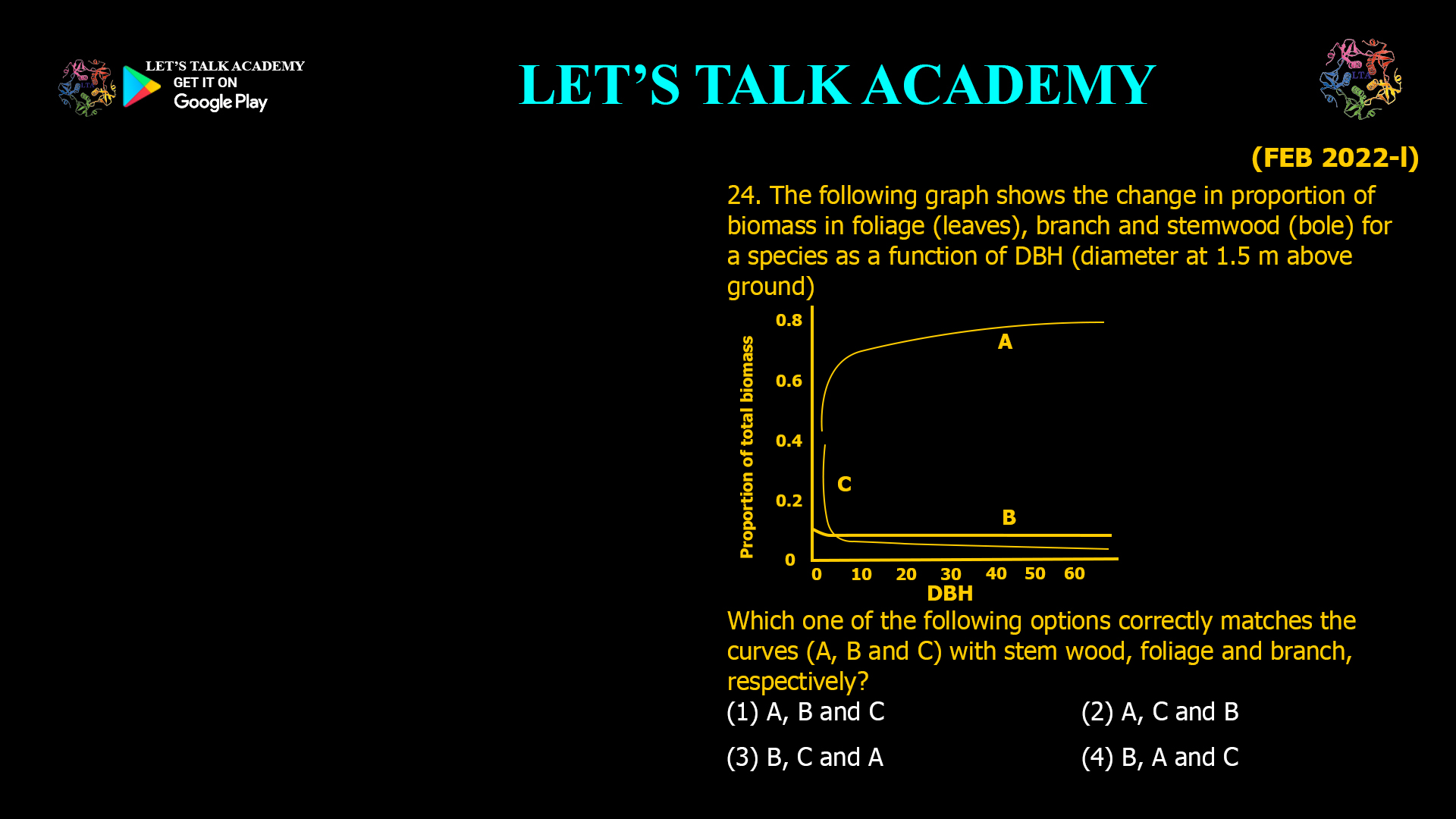- The following graph shows the change in proportion of biomass in foliage (leaves), branch and stemwood (bole) for a species as a function of DBH (diameter at 1.5 m above ground)

Which one of the following options correctly matches the curves (A, B and C) with stem
wood, foliage and branch, respectively?
(1) A, B and C (2) A, C and B
(3) B, C and A (4) B, A and C
Introduction
Understanding how tree biomass is distributed among different components—stemwood (bole), branches, and foliage (leaves)—is essential for forest ecologists, managers, and conservationists. As trees grow and their diameter at breast height (DBH) increases, the proportion of biomass in each component changes in predictable ways. This article explains the typical patterns observed in biomass allocation and guides you in matching graph curves to stemwood, foliage, and branch for a species as a function of DBH.
What Is DBH and Why Is It Important?
Diameter at breast height (DBH) is a standard measurement in forestry, taken at 1.3 or 1.5 meters above ground. It is a key indicator of tree size and is used to estimate biomass, growth, and carbon storage16. DBH is easy to measure and strongly correlates with tree structure and function.
Biomass Allocation in Trees
Tree biomass is distributed among three main components:
-
Stemwood (Bole):
The main trunk of the tree, which provides structural support and stores water and nutrients. -
Branches:
The woody extensions from the main trunk that support leaves and reproductive structures. -
Foliage (Leaves):
The photosynthetic organs that capture sunlight and produce energy for the tree.
How Do Biomass Proportions Change with DBH?
1. Stemwood (Bole)
As DBH increases, the proportion of biomass in the stemwood (bole) increases. Larger trees invest more in their trunks to support greater height and weight, and to transport water and nutrients over longer distances68. The curve representing stemwood biomass proportion typically rises steadily with increasing DBH.
2. Branches
The proportion of biomass in branches often peaks at intermediate DBH and then stabilizes or declines slightly. Young trees invest heavily in branches to maximize light capture, but as trees grow larger, the relative investment in branches decreases compared to the trunk. The curve for branch biomass proportion usually shows a hump-shaped pattern.
3. Foliage (Leaves)
The proportion of biomass in foliage (leaves) decreases as DBH increases. While the absolute amount of leaves may increase, the proportion of total biomass represented by leaves declines because stem and branch biomass grow faster than leaf biomass. The curve for foliage biomass proportion typically declines steadily with increasing DBH.
Matching Graph Curves to Biomass Components
Given a graph with curves labeled A, B, and C, and the question:
“Which one of the following options correctly matches the curves (A, B and C) with stemwood, foliage and branch, respectively?”Based on the typical patterns:
-
A: Stemwood (increasing with DBH)
-
B: Foliage (decreasing with DBH)
-
C: Branch (peaking at intermediate DBH)
Therefore, the correct option is:
(1) A, B and C
This matches stemwood, foliage, and branch to A, B, and C, respectively, as the question asks.
Why This Matching Makes Sense
-
Stemwood (A):
The proportion increases with DBH, so the curve rises. -
Foliage (B):
The proportion decreases with DBH, so the curve falls. -
Branch (C):
The proportion peaks at intermediate DBH, so the curve is hump-shaped.
Ecological Implications
Understanding how biomass is allocated among stemwood, branches, and foliage helps predict tree growth, carbon storage, and ecosystem function. It also informs forest management practices, such as thinning and harvesting, to optimize forest health and productivity.
Common Misconceptions
A common misconception is that the proportion of foliage increases as trees grow larger. In reality, the proportion of foliage decreases, while the proportion of stemwood increases. Another misconception is that branches always make up a larger proportion of biomass than stemwood in mature trees, when in fact, stemwood dominates in large trees.
Conclusion
As DBH increases, the proportion of biomass in stemwood increases, the proportion in foliage decreases, and the proportion in branches peaks at intermediate DBH.
When matching graph curves to stemwood, foliage, and branch, the correct order is:A: Stemwood
B: Foliage
C: BranchTherefore, the correct option is:
(1) A, B and C
-




5 Comments
Lokesh Kumawat
July 10, 2025Done
Kirti Agarwal
October 21, 2025A= stem
B= leaves
C= Branch
Santosh Saini
October 26, 2025A = stemwood , B = foliage , C = branch, so the option is 1st A, B, C
Sakshi Kanwar
November 27, 2025) A, C and B
Neelam Sharma
November 28, 2025A B and C